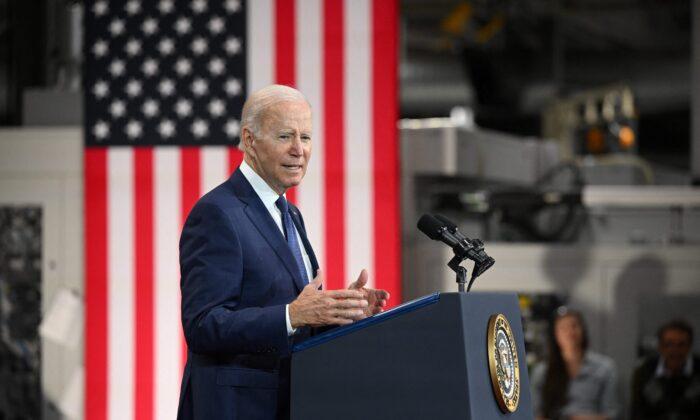Inflation news in July and August had offered a few willing souls so inclined to hope that price pressures would dissipate quickly. Consumer price inflation was indeed remarkably slow. Measures over the prior 12 months came off the frightening highs of more than 9 percent recorded last June.
The White House, for obvious reasons, was one of the most active purveyors of inflation hopes. In a widely quoted interview earlier this month, President Joe Biden emphasized how little ground inflation had gained in August, saying it had advanced only “an inch.” Technically, he was correct (though inflation is never measured in feet and inches.) In July, the overall CPI measure, called the “headline” figure, showed no advance; in August, it showed a gain of only 0.1 percent.
But as explained in earlier columns, the summer relief was due entirely to almost certainly short-lived downward adjustments in energy prices after their earlier and shocking upward spike. The retail price of gasoline, for example, fell 7.7 percent in July alone and then 10.6 percent in August. For the two months, these moves shaved 0.7 percentage points off the overall monthly inflation measure.
Otherwise, the rest of the CPI continued to soar. Food prices rose at close to a 12 percent annual rate during that time, and the price of housing rose at a 7.4 percent annual rate. The so-called core inflation rate—all items except food and energy—rose at a 5.5 percent annual rate, moderate by some standards but still a burden on consumers trying to maintain standards of living.
The same pattern repeated in September, but because the relief in energy prices was much more muted than in July or August, the more general inflationary problem showed through more clearly. According to the Labor Department, the cost of all energy products fell in September alone by some 4.9 percent, and the retail cost of gasoline fell by 2.1 percent. As in July and August, these declines moderated the so-called headline rate of consumer price inflation but were no longer enough to disguise underlying trends.
September’s overall rise in the CPI came in at about 0.4 percent or close to a 5 percent annual rate. Food prices continued their relentless and steep climb, rising 0.8 percent in September alone, a 10 percent annual rate. The price of shelter rose 0.7 percent for the month alone, an almost 9 percent annual rate. More telling—and more troubling—is that the core inflation rate rose 0.6 percent for the month, almost a 7.5 percent annual rate, and a marked acceleration from the 6.6 percent average during the prior 12 months.

More worrisome still is the likely path of energy prices in coming months. Just in the past few weeks, crude oil prices have risen some 16 percent. Futures prices on unleaded gasoline have risen some 17.5 percent during this time. And these figures don’t yet show the full price pressure implicit in Saudi Arabia’s recent decision to cut back production along with Russia and the rest of the Organization of Petroleum Exporting Countries (OPEC).
Price increases at the wellhead and the refinery may wait a month or two before they get to the retail gas pump, but matters clearly say that the kind of energy price relief of the past two or three months isn’t likely to persist and may well reverse. Even if energy doesn’t add to inflationary pressure, though it now seems likely to do so, the still powerful moves elsewhere should carry the headline figure up at a disquieting pace.
Though not especially likely, other components of the CPI may offer relief in the coming months. Even a modest easing in the pressure on food prices could have a considerable impact since food constitutes some 13.6 percent of the average household budget. But even if, by some unlikely chance, some individual component offers a good month’s reading, nothing on the horizon offers any reasonable hope that general inflationary pressures will dissipate anytime soon.
Whether slightly higher or slightly lower than in the recent past, unacceptable inflation is here to stay for a good while, and with it, continued pressure on the Federal Reserve to carry on with its planned interest rate increases and other anti-inflationary measures.





